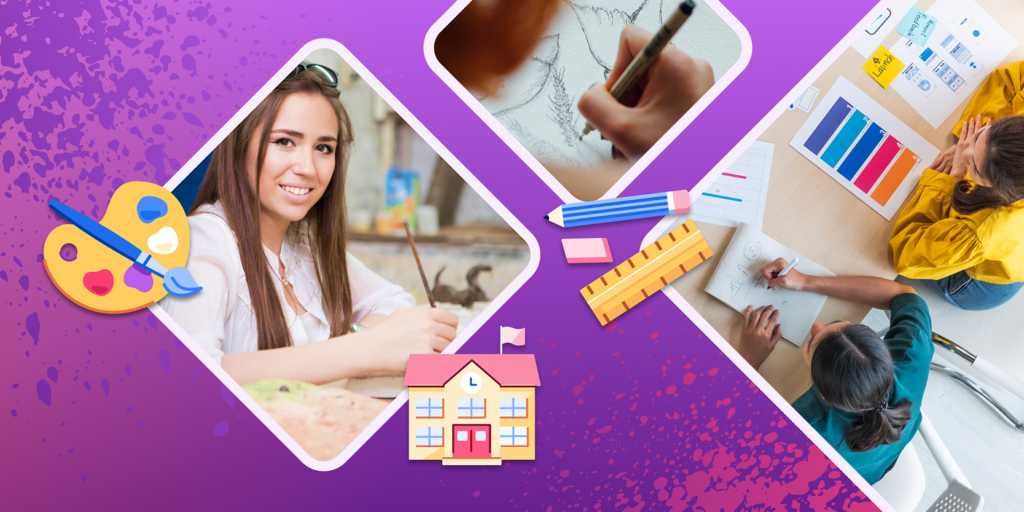Design is everywhere. It shapes the label on your toothpaste, the shoes you wear, and what the blog you’re reading looks like. While it’s pretty well-known that effective design and illustration can shape what people buy, design can also promote positive social behaviors. This includes things like encouraging recycling, or listening to important safety guidelines. So why study design and illustration as an international student? Whether you want to work in a creative space, help shape the world you want to see, or a bit of both, design and illustration are exciting fields. We’ll look a bit closer at possible careers in the field, reasons to study design, and more, below.
Still considering different study paths? The demand for health science grads is going up fast. Learn more about what studying health science is like, or why studying health sciences in Canada could be right for you.
How Do I Choose What to Study?
If you’re an international student planning to study design and illustration, think about the work you’d like to do and what your ideal work space looks like. How you answer can help you find your best fit. Some programs are more hands-on than others, with industry partnerships or work experience opportunities. Others might connect you with the broader creative community through workshops or events, thus building your professional network.
Some academic institutions teach design and illustration as separate specializations. So, consider your approach to creative work to figure out which is the better choice. Interested in using your art to tell a story, or want to work in publishing? Then illustration could be right for you. If you enjoy working in collaborative workspaces, and want to understand how images, text, and animation all impact each other, specializing in design is a great call. Either program will set you up well to work freelance or as part of a company, and you’ll learn many transferable skills.
Lastly, remember you don’t have to decide alone. Talk with your instructors, contact design groups on social media, or connect with local professionals. You’ll learn about different career paths and which programs suit your goals.
What’s a co-op like, versus a placement? Learn about work-integrated learning opportunities on our blog.

What is Working in Design and Illustration Like?
Studying illustration and design sets grads up for so many different careers. You could create company branding, illustrate a children’s book, master web design, work in fashion, or produce theatre, TV, or film.
Other design grads work with multidisciplinary teams:
- Product designers work with other creatives and manufacturing teams to decide what physical objects (from bookshelves to blenders) will look like.
- Architectural designers use computer-aided drawing (CAD) software to create building plans based on architectural sketches, working closely with architects and engineers.
- Video game designers use software and illustration skills to create game elements like visual effects and character design.
If you can adapt quickly and enjoy working with lots of different kinds of people, you can excel in these roles.
Some creative grads work on a freelance basis. This can be appealing because you pick which work you want to do and when you want to do it. As a freelancer, you’re your own boss. When you freelance full-time, you choose where you want to work (at home? a cafe? a coworking space?), can contract with clients worldwide, and you keep all the profits! However, it also means you have to find the work, manage estimates and billing, and promote your skills—in addition to the creative tasks you’re hired for.
Working freelance full-time works well if you want to build your business and communication skills, prefer working on your own schedule, or if you aren’t a primary income earner for your household. However, freelancing isn’t the best fit if you like a regular schedule or want access to work-supplied benefits.
Check out these featured arts and design programs at institutions in Canada, the United Kingdom, and the United States!

Join an Evolving Field
In the United States, job openings for web developers and digital designers are expected to grow by 23% from 2021–2031. This growth rate is much faster than the average for all occupations. That’s hopeful news for students entering design and illustration programs!
In Canada, the federal Job Bank predicts good employment opportunities for illustrators and graphic designers and user experience (UX) designers over the next three years in Alberta and Quebec.
Australia‘s federal Your Career page predicts a strong outlook for many design- and illustration-based roles over the next five years, from advertising managers and visual arts and crafts professionals to graphic designers. Multimedia specialists and web developers fare even better in the Australian market, with a predicted future demand of “very strong.”
As technology continues to evolve, design teams will play many important roles. Maybe you’re interested in figuring out what that technology looks like (got an idea for the next iPhone)? Or you’ll help a new business figure out its brand. Maybe you’ll shape how users interact with your company’s technology on the UX team. No matter which path you choose, your skills can make a difference.
Considering programs in different countries? Check out our blogs on how to choose where to study in Australia, Canada, the United Kingdom, and the United States.
We hope this post has inspired you to consider a design or illustration program as a future international student! Next, watch for our blog on why studying design in Canada is a great idea.
Ready to study abroad? Register for free with ApplyBoard for international study resources and support.




